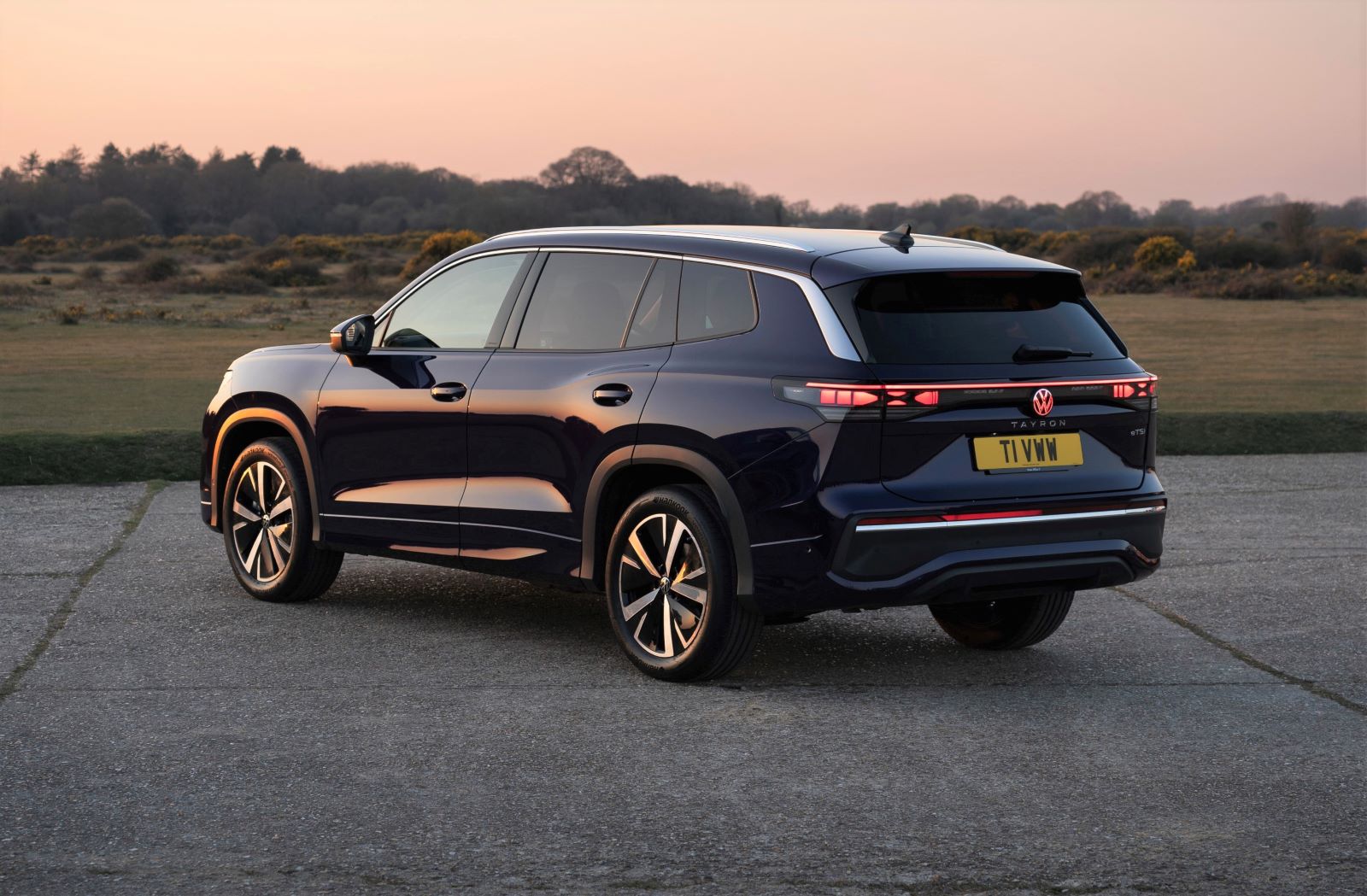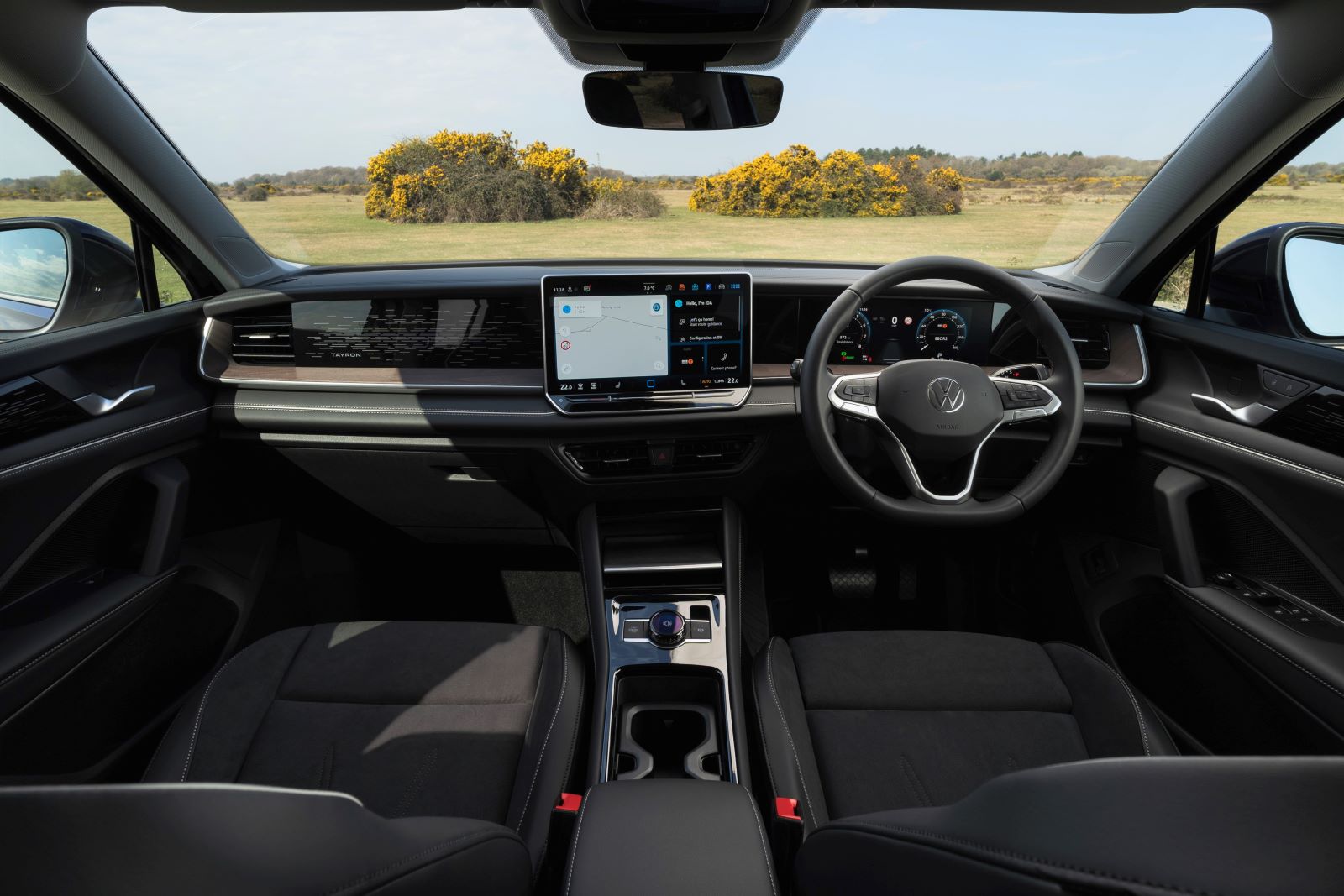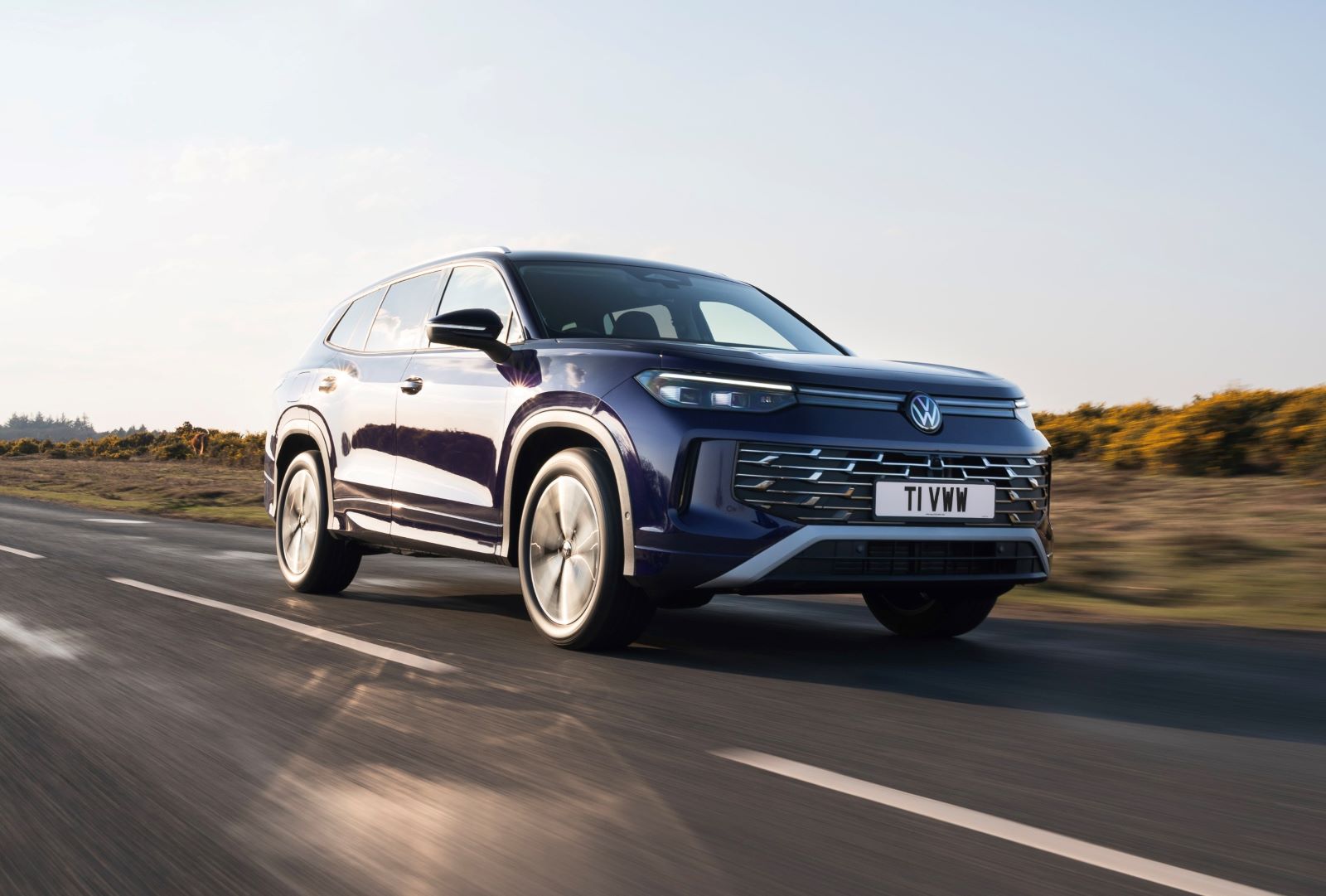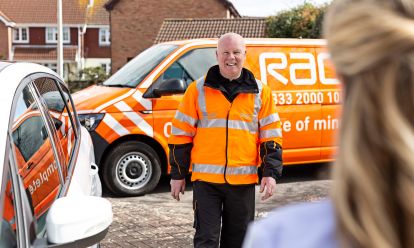
RAC sale – up to 33% off*
• Roadside cover from £5.29 a month†
• We get to most breakdowns in 60 mins or less
• Our patrols fix 4/5 breakdowns on the spot

The Volkswagen Tayron is a larger, seven-seat version of the Tiguan. Is it one of the top large family SUVs? We delve deeper to find out.
Things you'll like
- Spacious, with flexible seating
- Rides and handles well for a big SUV
- An engine option to suit every need
Things to consider
- Third row of seats could be roomier
- Hybrids are five-seat only
- Sluggish gearbox response
What is the Volkswagen Tayron?
From Touareg to Taigo, Volkswagen has no fewer than eight SUVs beginning with the letter T. So where does this, the new VW Tayron, fit in?
Well, in simple terms, you can think of the Tayron (pronounced ‘Tie-ron’) as the replacement for the Tiguan Allspace – for many years the sole seven-seat SUV option in the brand’s range. It sits below the Touareg which, confusingly, is five-seat only.
The idea behind the Tayron is similar to what Nissan did with the old Qashqai+2, which became the X-Trail in its second generation. The idea is to create a distinct model in its own right, so buyers don’t see that it’s merely a stretched version of an existing car.
The Volkswagen Tayron offers a wide variety of petrol, diesel and plug-in hybrid engine options (the latter, sadly, only offered with five-seats and a vast boot). But should you consider it above already established seven-seat SUVs? Our in-depth review delves into the details.
Verdict: is the Volkswagen Tayron a good car?
The Tayron is a solid, sensible all-rounder and a welcome addition to the seven-seat SUV class. Sure, there are roomier and more luxurious options out there, but the VW’s reasonable price, good tech, solid interior and decent driving experience make it well worth considering. You might well prefer the Skoda Kodiaq, however.
Pricing, specs & rivals
The Volkswagen Tayron’s £40,130 starting price (correct as of August 2025) is roughly £2,000 more than the Skoda Kodiaq, but bear in mind that seven seats are an extra on the base Kodiaq and standard on the Tayron.
It’s a pity that VW couldn’t keep the base Tayron’s list price under the £40,000 barrier because it means every version is liable for the Expensive Car Supplement – an additional annual car tax for five years after first registration.
That price gets you the 1.5 eTSI in Life trim. The 2.0 TDI diesel costs from £41,320, while you’ll need just over £44,000 for the lower-powered plug-in eHybrid. Life trim gets a decent kit tally including 18in alloys, three-zone climate control, adaptive cruise control, LED headlights wireless phone charging, a rear-view camera and ambient lighting.

Match trim is technically the next trim level above, but it’s only available with the plug-in hybrid model so starts at £45,315. It adds an opening front sunroof and fixed rear sunroof, Park Assist with a memory function, a gesture controlled electric tailgate, laminated privacy glass and keyless entry .
Elegance trim is the next cheapest above Life, at £42,700. That further adds 19in alloys, additional exterior lighting elements and improved ambient cabin lighting, heated and massaging front seats, a heated steering wheel and wood trim.
R-Line trim, from £43,105, ditches the sunroofs and focuses on sporty styling upgrades including 20in alloys, chunkier bumpers and sports seats. It also gives you the option of higher-powered eHybrid and the two 2.0 TSI petrols – the most powerful models push the price over £50k.
Top-spec R-Line Edition adds primarily adds in a larger Panoramic roof and is only available with either plug-in hybrid.
Rivals
Chief among the list of rivals for the Volkswagen Tayron is its VW Group sibling, the Skoda Kodiaq, which is slightly cheaper to buy. The Peugeot 5008 and Nissan X-Trail are other key alternatives to consider, while more premium options include the Kia Sorento, Hyundai Santa Fe and Mazda CX-80.
If you’re considering an electric seven-seater, the Kia EV9 is a great (if pricey option), which also consider the VW ID Buzz which is even more practical, if also expensive.
Interior comfort, quality & technology
It probably won’t surprise you to learn that, up front at least, the Tayron’s interior is identical to the Tiguan. And that’s no bad thing, because it’s a comfortable and mostly easy to live with cabin that’s generally well-built.
You’ll find plenty of soft-touch materials, along with an overall feeling of solidity. Opt for Elegance trim and above and you’ll also get neat patterned ambient lighting effects on the dash and doors. Overall it looks and feels more premium inside than a Skoda Kodiaq, but the Hyundai Santa Fe raises the bar even further.
Finding a comfortable seating position is a doddle, too, with plenty of adjustment in the seat and steering wheel. With narrow front pillars, a low dashboard and large side windows you also get excellent all-round visibility – even the view out the back is good by modern car standards.
Our only gripes with the Tayron’s cabin are minor, such as the lack of physical climate controls up front. We wish VW mirrored the related Skoda Kodiaq with physical knobs to adjust the fan speed and temperature. While there is a single physical dial with an OLED screen, it can only adjust the volume or the car’s drive modes.

Infotainment, sat-nav, stereo and connectivity
Every version of the Tayron comes with a 12.9-inch infotainment touchscreen standing proud of the dash. It features wireless Apple CarPlay and Android Auto, along with sat-nav, wireless phone charging and natural speech voice control.
It’ll be plenty big enough for most, but if you have a pressing need for screen size bragging rights you can upgrade it to a massive 15 inches. That also adds a handy head-up display, too, and ChatGPT AI integration for even cleverer voice functions.
Both screens feature the same sharp graphics and decent response times, with good usability thanks to customisable shortcuts – it’s a slightly better system than the one you’ll find in a Hyundai Santa Fe or Kia Sorento. Our only gripe is the lack of physical shortcut buttons and somewhat fiddly touch-sensitive panel below the screen.
You do get proper steering wheel buttons, along with a 10.3-inch digital driver’s display with lots of different layouts and sharp graphics.
Front and rear USB-C connectors feature for further connectivity (though you won’t find any in the third row) while all versions have a dual-phone wireless charging pad. The base eight-speaker sound system is decent enough, but audiophiles should upgrade to the 10-speaker, 700-watt Harmon Kardon system.
How practical is the Volkswagen Tayron?
It’s clear to see how closely related the Volkswagen Tayron is to the Tiguan when you look at the former’s dimensions. At 4,770mm long, 1,852mm wide and 1,660mm tall the Tayron is about 230mm longer than the Tiguan, but identical in width and height.
About half of the Tayron’s extra length over the Tiguan goes into its wheelbase (the space between the front and rear wheels) with the rest in the rear overhang to enable that extra row of seats.
Up front, there’s absolutely no difference in space between the Tayron and Tiguan – that means plenty of room for even the tallest or broadest adults, and a wide cabin.
All versions of the Tayron get a middle row of seats that can slide back and forth with a 60/40 split, making it easy to juggle legroom for the middle or rearmost row. With just the middle seats occupied there’s loads of legroom and plenty of space to slide your seats in front.
Headroom in the middle seats isn’t as generous as you might think – those well over six-foot may find their heads brushing the roofline if the panoramic roof is fitted. But you can recline the backrests to mitigate this and give a more comfortable seating position. The middle seat is decently wide and reasonably comfortable if you need to carry three people across the second row.
And the third row? Well, a wide-opening rear door means access is pretty good, while it’s easy enough to fold the middle seat forward to gain access. Adults will need to crouch a bit to get in, but kids have plenty of space to jump into the back.
VW admits that this rearmost row is really designed for children, but it is possible to fit an average-sized adult in with the middle seats slid forward a bit to free up legroom. It’s not exactly comfortable for long distances, though, particularly as headroom is a bit tight and your knees are raised up.
Overall, a Hyundai Santa Fe is roomier for adults back there, but the Tayron is similar to the Skoda Kodiaq and has more usable rear seats than the old Tiguan Allspace.

Storage and boot space
The Tayron offers plenty of storage up front for family detritus. You’ll find generously-sized door bins with felt lining to reduce rattles, a big glovebox, a pocket for your sunglasses in the roof and a deep centre armrest.
That armrest hides moveable dividers to add flexibility, while the cupholders in front of that can be removed to create another space for bits and bobs. Finally, there’s a space for two phone in a lidded storage cubby under the dash.
In the middle row of seats the door bins remain a good size, while you’ll also find a centre armrest with pop-out cupholders, pockets at the bottom of the front seatbacks and two smaller ones for phones on top.
The rearmost seats are less well catered for. Some pricier rivals have cupholders, USB ports and even climate controls back there, but VW only gives seats six and seven a couple of small phone holding trays.
The boot, meanwhile, is pretty vast. Even with all seven seats in place you still get 345 litres of capacity – about the same as the boot on a Volkswagen Polo. Fold those rear seats down (easily done via levers next to the headrests) and you get a substantial 850-litre boot – more than the Santa Fe.
You can also fold the middle seats entirely if you’re planning a big tip run to liberate a massive 1,949 litres of space. Those seats fold in a 40/20/40 split via boot-mounted levers, so you’ll be able to carry long items such as skis while still carrying two people in the middle row.
The boot itself has plenty of practical touches including plentiful underfloor storage and chunky side pockets to stop smaller items rolling around.
There’s one big caveat with the plug-in hybrid models. They’re five-seat only, and even without those rear seats overall boot space is reduced due to the batteries sitting under the floor. Still, its 705-litre capacity is still capable of swallowing a pair of pushchairs with ease.
Performance & drive: What is the Volkswagen Tayron like on the road?
The Tayron has a near-identical engine range to the Tiguan on which it’s based but carries a touch over 100kg of extra weight. That means performance is dulled slightly, though not noticeably so.
The entry-level 130hp 1.5TSI is thankfully ditched as it would be too underpowered in the seven-seat Tayron. Instead, the base point is the 150hp version, which offers pace best described as ‘adequate’,
It’s punchy enough when unladen and will be sufficient for most people’s needs, but load the Tayron up with passengers and luggage and it’ll start to feel a bit lacking when trying to build speed to join a motorway or overtake.
The 150hp diesel is no quicker on paper, but with 110Nm more torque on offer it’ll feel considerably punchier in real-world situations. It’s well worth the upgrade over the petrol if you’re planning on filling the Tayron regularly. It’s also capable of towing up to 2.5 tonnes.
The plug-in hybrid offers class-leading electric range in 204hp form along with ample, if not thrilling performance. Upgrading to the 272hp version gives gutsier performance but, as with the regular Tiguan, it can be a bit unruly if you floor it from low speed.
The 2.0 TSI models offer effortless acceleration and plenty of low-down grunt. Again, you wouldn’t call either sporty, but they combine the torque of the diesel with greater refinement. They both come with 4MOTION four-wheel drive, too, so put their power down much more smoothly than the 272hp eHybrid.
Most versions of the Tayron have a seven-speed DSG automatic gearbox, with the hybrids using a six-speed. While smooth most of the time, they can occasionally be jerky and dim-witted when you need a quick burst of acceleration, such as entering a busy roundabout. It’s a shame, because VW’s DSGs used to be snappier.
Power, 0-62mph times
- Tayron 1.5 eTSI 150: 150hp/ 9.4 secs
- Tayron 2.0 TDI 150: 150hp/ 9.7 secs
- Tayron 2.0 TSI 204: 204hp/ 7.3 secs
- Tayron 2.0 TSI 265: 265hp/ 6.1 secs
- Tayron eHybrid 204: 204hp/ 8.6 secs
- Tayron eHybrid 272: 272hp/ 7.3 secs
Ride and handling
We would describe the VW Tayron as a jack of all trades in the ride and handling department. While that sounds like damning with faint praise, very few seven-seaters offer much in the way of driver appeal, and it’s not why you’d buy one in the first place.
To that end, the Tayron is a solid all-rounder. With the standard suspension the low-speed ride is a touch on the firm side, but it’s slightly less fidgety than the Tiguan (possibly thanks to the extra weight). It also feels much like a Tiguan in the bends, with accurate steering, good grip levels and little body lean for such a large car.
The best way to improve the ride comfort is to either avoid the larger wheel choices, or opt for the DCC pro adaptive suspension which standard on the plug-in hybrids or 2.0 TSI petrols. With that fitted it offers a broad remit between tight body control on twisty, undulating tarmac in the sportiest setting, and a well-cushioned ride in Comfort mode.
Noise and refinement
The Tayron is a very refined cruiser overall, with low levels of wind and road noise at a motorway cruise. The 1.5 TSI petrol engine gets a bit vocal when you rev it out (as you’ll need to given its modest performance) but it settles down at a cruise, while all other units are smooth and quiet. Of course, that applies most to the plug-in hybrids when running in electric mode.

Euro NCAP: is the Volkswagen Tayron a safe car?
The VW Tayron managed the maximum five-star safety rating when crash tested by Euro NCAP, hitting the standard expected of a large family car.
Its 87% rating for adult occupant protection is higher than the Santa Fe, but the Tayron falls slightly behind the Hyundai for child occupant protection. It’s among the best large SUVs for safety assist and vulnerable road user protection scores, however.
All versions of the Tayron come loaded with safety kit. Alongside the usual automatic emergency braking, lane keep assist, driver attention monitor and traffic-sign recognition, kit such as blind-spot monitoring and rear cross-traffic alert is standard across the range. You also get a total of nine airbags to protect everyone in a collision.
Running costs and fuel economy
The Tayron is economical for a seven-seat SUV, even in petrol form thanks to mild-hybrid tech on the big-selling 1.5-litre unit. 45mpg in the official WLTP test is impressive, and only fractionally down on the Tiguan with the same engine.
The jump in economy to the diesel isn’t as much as you’d expect, on paper at least. Managing 49.3mpg combined, it’s strong but perhaps not enough to offset the higher cost of the diesel version and the fuel itself at forecourts.
The 2.0 TSI models are quite thirsty by the standards of today. The 204hp version manages 35.6mpg combined, while the 265hp model takes that down to 32.9mpg. Some may be prepared to accept that given the performance, but higher insurance and first-year tax costs are worth bearing in mind.
The eHybrid models look great on paper. With an outstanding 71 miles of range from a battery with a 20kW usable capacity, it’s six miles down on the Tiguan – and double that of the Santa Fe PHEV. The 272hp version only loses one mile of that.
That gives official economy figures of 634mpg for the 204hp eHybrid and 631mpg for the 272hp one. As with all plug-in hybrids you won’t get anywhere near that figure without frequent charging – expect 45mpg or so with a depleted battery.
How much does the Volkswagen Tayron cost to insure?
The Volkswagen Tayron shouldn’t break the bank in terms of insurance costs, with entry-level versions sitting in insurance group 24. That’s higher than base versions of the Skoda Kodiaq but lower than the Kia Sorento and considerably lower than the hybrid-only Hyundai Santa Fe.
Upgrading to hybrid versions of the Tayron pushes these groups higher, and the 2.0 TSI 265 tops the range in insurance group 34.
Volkswagen Tayron FAQs
Is the VW Tayron coming to the UK?
Yes, the Tayron is available to order now in the UK. It used to be a China-only model, but this generation is based on the European VW Tiguan.
Is the VW Tayron bigger than a Tiguan?
The VW Tayron is identical in size to the Tiguan in width and height, but it’s 230mm longer overall at 4,770 mm long. It’s also 100kg or so heavier.
How much is the VW Tayron to buy?
The VW Tayron starts at £40,130 for entry-level versions, rising to over £50,000 for top-spec models with the most powerful engines. Prices are correct as of August 2025.








